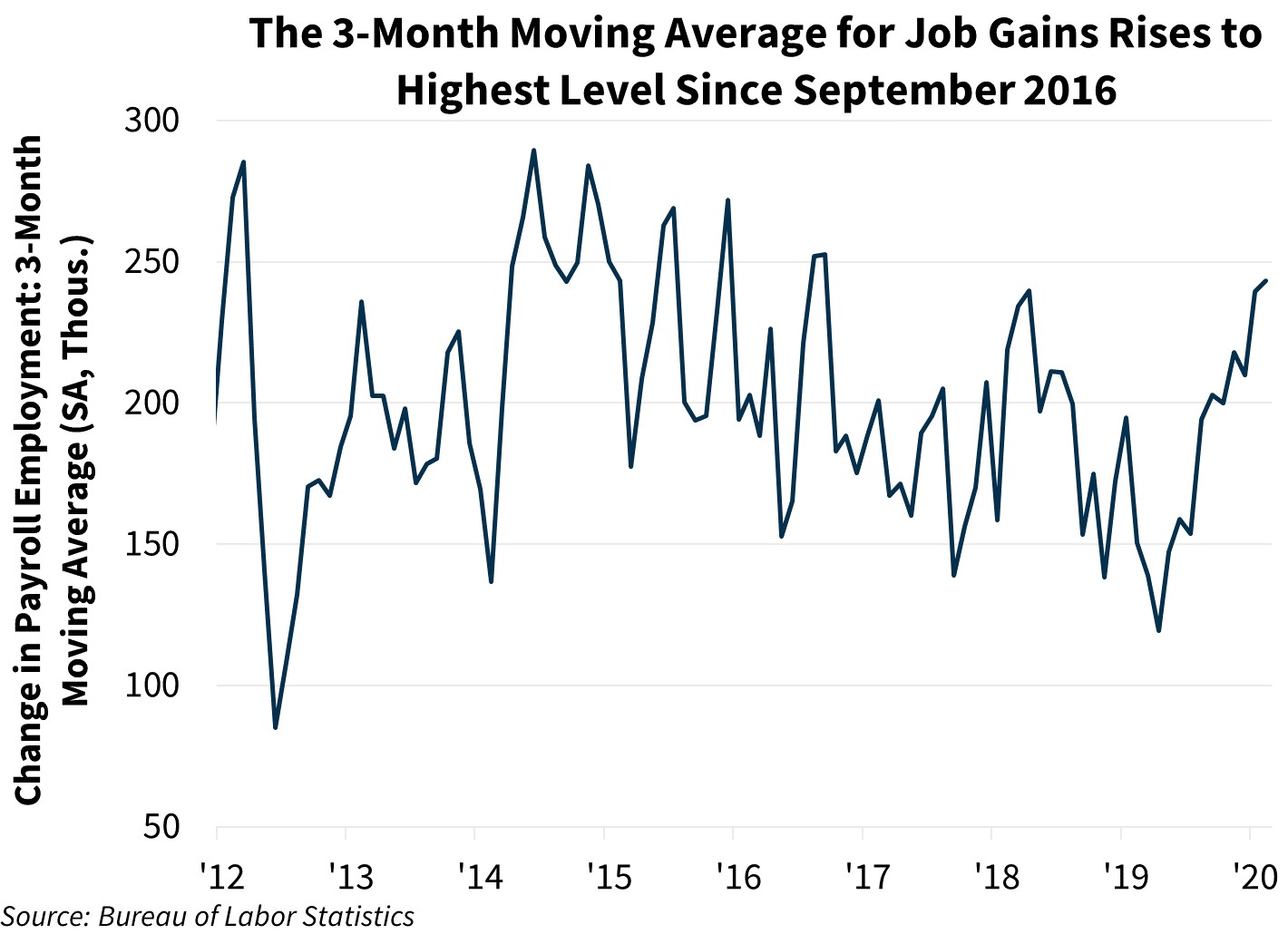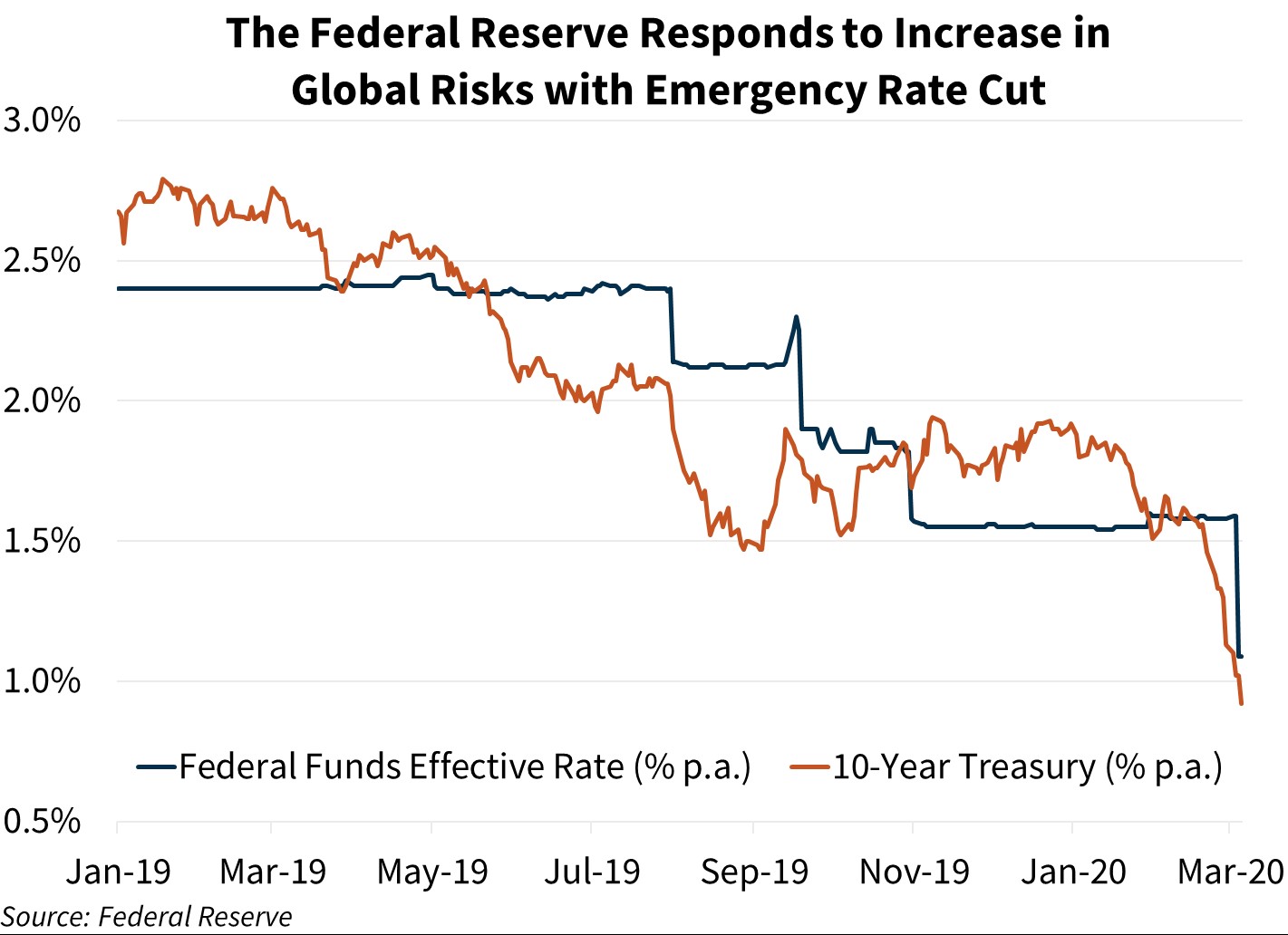Job Growth Rises Well Above Consensus Expectations, Though Risks Remain
Key Takeaways:
- Following a spell of financial instability in which the 10-year Treasury yield fell below 1.0 percent for the first time ever, the FOMC cut the federal funds rate by 50 basis points to a range of 1.00 to 1.25 percent at an emergency meeting held on March 3, citing that while “the fundamentals of the U.S. economy remain strong, the coronavirus poses evolving risks to economic activity.” The FOMC will meet for its regularly scheduled meeting on March 17-18, with fed fund futures expecting further cuts at that meeting.
- Job growth remained robust in February with a gain of 273,000 jobs, according to the Bureau of Labor Statistics. Job gains were revised upward by a total of 85,000 for the prior two months, which helped push the 3-month moving average to the highest level since September 2016. The unemployment rate fell one-tenth to 3.5 percent, tying a 50-year low.
- Factory orders and shipments both fell 0.5 percent in January, according to the Census Bureau. Nondurable goods orders and shipments fell, the first decline for both since last September.
- The ISM Manufacturing Index edged down 0.8 points to 50.1 in February, eking out another month of expanding activity (i.e., an index reading above 50). The new orders index has contracted for six of the past seven months. The imports index posted the largest monthly decline in the history of the series, ending February at 42.6, the lowest level since 2009. The ISM Nonmanufacturing Index, a gauge of service sector activity, rose in February to the highest reading in a year.
- Private residential construction spending rose 2.1 percent in January to the highest level since May 2018, according to the Census Bureau. The increase in new home construction was driven entirely by the single-family sector, which rose 2.8 percent, while new multifamily construction spending was essentially unchanged.
Forecast Impact
Financial volatility and an inverted yield curve led the Fed to cut rates, though the data this week support Chairman Powell’s assessment of strong economic fundamentals. The strength in February job gains, as well as the strong upward revisions to the prior two months, continue to suggest that the labor market is healthy, which should support consumers and, subsequently, growth. Due to the timing of data collection in the labor report, it was unsurprising that there was no observed impact from recent coronavirus news, and we do not expect to see much of an impact in next month’s report either due to the time and expense required for firms to consider staffing decisions. Declines in both the ISM Manufacturing new orders and imports components highlight the disruption that the coronavirus has caused to global supply chains, which could also affect consumer confidence in the coming months, a downside risk to our forecast. For housing, the unusually warm weather in January likely helped boost new single-family construction spending, suggesting a stronger first quarter for residential fixed investment than we are currently forecasting. The boost in residential construction employment is also a boon for the housing market, which has faced a continued shortage of labor.


Details on Key Takeaways and Other Releases
- Nonfarm payroll employment increased 273,000 in February, according to the Bureau of Labor Statistics, and the three-month moving average also rose to 243,000. The average workweek ticked up one-tenth to 34.4 hours, while average hourly earnings increased 0.3 percent over the month (and 3.0 percent from a year ago). The labor force participation rate for workers 16 years and older was unchanged at 63.4 percent, but the prime-age (25- to 54-years old) labor force participation rate fell to 83.0 percent, the first decline since July 2019. Manufacturing employment rose by 15,000 and residential construction employment (which includes specialty contractors) grew by 21,900, the second largest gain in a year.
- The U.S. trade deficit narrowed by $3.3 billion in January to $45.3 billion, according to the Census Bureau. Exports fell 0.4 percent, while imports fell 1.6 percent. The real goods trade deficit narrowed by $2.3 billion to $77.7 billion.
- Factory orders fell 0.5 percent in January, according to the Census Bureau. Nondurable goods orders and shipments both fell by 0.8 percent. Core orders (nondefense excluding aircraft) rose 1.1 percent, unchanged from the advance report, while core shipments rose 1.0 percent, one-tenth lower than in the advance report.
- The ISM Manufacturing Index fell 0.8 points to 50.1 in February. The new orders index fell 2.2 points to 49.8. The production index fell 4.0 points to 50.3 and the inventories index fell 2.3 points to 46.5. The imports index fell by 8.7 points. The ISM Nonmanufacturing Index rose 1.8 points in February to 57.3. The new orders index jumped to 63.1, the highest reading since June 2018. The orders backlog index, not seasonally adjusted, jumped 7.7 points to 53.2, the highest reading since September 2019. Any reading above 50 indicates expansion.
- Private residential construction spending rose 2.1 percent in January, according to the Census Bureau. Spending on new residential improvements rose 1.5 percent. From a year ago, new single-family construction spending rose 10.0 percent, the fastest pace of growth since May 2018, while multifamily spending fell 9.7 percent, the largest decline since February 2011.
Economic and Strategic Research Group
March 6, 2020
Opinions, analyses, estimates, forecasts and other views of Fannie Mae's Economic and Strategic Research (ESR) Group included in these materials should not be construed as indicating Fannie Mae's business prospects or expected results, are based on a number of assumptions, and are subject to change without notice. How this information affects Fannie Mae will depend on many factors. Although the ESR group bases its opinions, analyses, estimates, forecasts and other views on information it considers reliable, it does not guarantee that the information provided in these materials is accurate, current or suitable for any particular purpose. Changes in the assumptions or the information underlying these views could produce materially different results. The analyses, opinions, estimates, forecasts and other views published by the ESR group represent the views of that group as of the date indicated and do not necessarily represent the views of Fannie Mae or its management.
